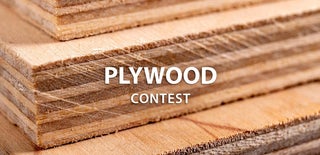Introduction: Teardown Stage With Steps
So this project was conceived for small stage events, with the feature of being lightweight and able to be struck quickly for storage and travel. It can easily be moved by one or two people and a small truck or roof-rack.
The 4x8' floor is a torsion box, and can support a significant amount of weight edge-bearing, with minimal deflection in the middle.
The steps on either side solidly interlock into place with mechanical joints and T-nut fasteners. They are keyed in the middle to support high impact and weight. The consideration was that they could also be used on a construction site on their own.
I applied a cork-based product to the torsion box stage platform bottom to keep it from sliding, but it could easily be fastened with bolts for surety.
Supplies
5 Sheets 3/4" Exterior plywood
2 Sheets 1/2" Exterior plywood
Crown staples, pin nails, or screw fasteners
Waterproof exterior wood glue
20 Stainless steel T-nuts
Step 1: All the Cuts
So we need to get all the grid pieces cut for the torsion box, I used 12" centers for this build. I cut mine with a cnc, but they could easily be done from a single pattern and a flush trim router bit. They are literally just notched so you can fit them together upright.
I also used a cnc to cut my steps components, but it's really just the keys and consistency that are important here. You can see there are only 6 different pieces, so a pattern jig would work fine.
Step 2: Glue Up Grid Pieces.
I clamp them together so I can fill all the channels quickly without the glue spilling down the space between the grid pieces
Step 3: Sand and Glue
Now the grid is all glued up, a rough sand of both the top of the grid and the areas of the plywood that will contact will maximise surface area to improve adhesion. Marking the grid from the other side with chalk or pencil allows us to use fasteners in addition to the glue if we wish.
I use a roller to apply a heavy coat of waterproof Exterior wood glue to the top of the grid before fastening the plywood. We will use a 1/2" piece of full plywood for what will become the bottom of the platform.
Note: You really want a flat spot here, but if you are using sawhorses, then you want any error/bend to be on the upward not downward side. The fact is that once we apply the top layer in the next step, it should be either flat or arched up. Arched down decreases strength, Arched up increases it, and Flat makes things consistent.
Step 4: Flip and Paint Seams
In this step we are sealing any gaps between the grid and the plywood sheet. You can use any paint, the point is to seal any gaps so there is no single point of movement along the grid contact with the plywood.
Step 5: Glue the Top
Same story, sand and glue, square it up and add fasteners on the chalk lines. Use a full 3/4" sheet for the top in case you need to put a piano on it.
Step 6: Steps: Get a Corner
Get one corner back and side in place
Step 7: Add the Rises
The rises can just hang there for a minute
Step 8: The Other Side
Get the other side in place from the back
Step 9: Join the Risers
Really, just push them down into place.
Step 10: Click Those Runs
So there are two sets of keys in the runs. One clicks in to the rise in the middle to improve load bearing on the step, and the other consists of two keys on the underside that click into place after you insert them into the rise. This keeps the rise in place upright for maximum strength. They are marked in purple in the second image, and are pocket keys, and only go 3/8" in to the plywood to fit the bumps at the top of the riser pieces.
Step 11: The T-nut
This step really holds it all together. The T-Nut ensures that the runs stay in place and locked in to the keys of the rise, as well as providing a lifetime of teardown/rebuild opportunities.
Step 12: Throw It Into Place
Really, just set it up anywhere. A bit of shim around the bottom of the steps should be all that it takes to get it all sitting pretty. The torsion box is designed to bear load right from the edge, it is up to you to make sure everything is tight and tested.

Participated in the
Plywood Contest









